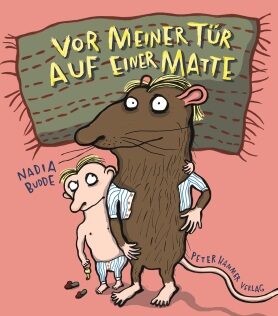Nadia Budde
Vor meiner Tür auf einer Matte
[Before my door upon a mat]
- Peter Hammer Verlag
- Wuppertal 2016
- ISBN 978-3-7795-0539-6
- 32 Pages
- 3 Suitable for age 4 and above
- Publisher’s contact details
Nadia Budde
Vor meiner Tür auf einer Matte
[Before my door upon a mat]
Sample translations
So what's better: share your life, or live alone?
One day the rat – a not exactly popular kind of animal – turns up unbidden at the man’s front door. ‘"Do come in!" I rarely say / – she mostly slips in anyway.’ – thus begins Nadia Budde’s rhyming tale. Without the least stirrings of conscience the rat expropriates the man’s slippers (far too small though they are), commandeers the comfortable brown armchair in the living room, and hogs the bathroom. The man spells out all the rat’s disagreeable traits and habits, and complains bitterly to the reader. He can’t even read in peace: ‘If in a book I seek good cheer, / her constant snuffling fills my ear.’
This uninvited togetherness makes him blow his top at some point, and all of a sudden there’s no longer any sign of the rat: an abrupt, unexpected turn of events – and one that creates a new kind of tension. Who would have thought it, but this new situation doesn’t suit the man either. He now misses all the things that previously got on his nerves. Living all on his own for any length of time isn’t much fun after all. And what a marvel: ‘Some time later I come back / – she’s right there, and brings the joy I lack!’
Nadia Budde succeeds in giving effective narrative and pictorial shape to a topic relevant to all of us. As in all Budde’s other books, both children and adults can approach this one from a whole variety of different vantage points. How close can we live to other people, and how much personal space does each of us need? With biting humour Budde captures typical situations, and lets the story carry on beyond the supposed happy ending: as the rat lies there snoring by the man’s side with an entire tribe of rats standing just outside the front door, we immediately realise that new conflicts lie ahead.
This is an altogether compelling idea for a book. ‘I can’t tell where my ideas come from’, Nadia Budde has remarked, ‘But especially in the case of this book the idea presented itself quite suddenly and, in contrast to my other books, in almost fully fledged form.’ Her catchy rhymes make it very easy for anyone wanting to read the book to a child: with its pithiness and punchy rhythms it is perfect for reading aloud. It’s clear from Budde’s own work that she has a high regard for Wilhelm Busch, Joachim Ringelnatz, Dr Seuss and Robert Gernhardt.
‘Image and text are so intimately related that that it’s difficult to say which comes first’, says this Berlin author. ‘The two aspects complement and support each other, and each arises out of the other.’ Her illustrations are done in a particular and unmistakable style, which has fascinated readers right from her debut in 1999. The board book ‘Eins Zwei Drei Tier’ (English-language edition: ‘One, Two, Three, Me’) was immediately awarded the German Youth Literature Prize. She begins by using felt-tip pens and brushes with black ink. She then scans her drawings, and only adds colour at the digital stage. There is little in the way of backgrounds – instead, physical spaces are merely hinted at, with just a telling ‘prop’ or two; the free-flowing outlines of the figures are strongly drawn in black, and the figures themselves have marked facial expressions – a feature that is particularly important to Budde. It is these elements that constitute the chief characteristics of her pictorial language.
The round white eyes of her figures are especially striking, and so too, in this book, are the unexpected similarities between rat and human. This is a perspective that Budde had already played with in her earlier book ‘Und irgendwo gibt es den Zoo’ (‘Who knows where, there’s a zoo out there’). And when Budde arranges the two figures on an armchair, a remarkable symmetry becomes apparent in the depiction of their hair, ears, nose, mouth and chin – except that the rat is decidedly bigger than the man! Another characteristic Nadia Budde feature is the fact that the typography is integral to her design. ‘The script is part of the drawing’, says Budde; ‘When I first create the illustration, I include the writing at the same time.’ This element, too, helps to make her clever, witty and offbeat picture books instantly recognisable.
Translated by John Reddick

By Antje Ehmann
Antje Ehmann is a freelance journalist. Specialising in books for children and young adults, she writes for various publications including ‘Neue Zürcher Zeitung’, ‘BuchMarkt’, ‘BÜCHER-MAGAZIN’, ‘dpa-Kindernachrichten’ and ‘mare’. From 2011 to 2014 she was a member of the Critics’ Jury for the German Youth Literature Prize (Deutscher Jugendliteraturpreis), and in 2016 she became a member of the jury for the Illustration Prize for Children’s and Youth Literature (Illustrationspreis für Kinder- und Jugendliteratur) offered by the Gemeinschaftswerk der evangelischen Publizistik.
Publisher's Summary
Nadia Budde’s protagonist is no longer master in his own house: he has a visitor who won’t stop visiting – namely the rat. There she is, standing on his doormat every day when he arrives home, very cheerful and very large. And once inside the house she dons his slippers and makes herself completely at home: on his sofa, on his piano stool, in his bed. Always pushing herself to the fore, she has first go at the bath, the fridge, the mirror. She monopolises the phone, she’s loud and irritating, until it’s all too much even for our long-suffering hero, and he finally blows his top. Then all of a sudden, she’s gone. Oh dear! Instead of feeling relieved, our hero is overcome with sadness and his home seems desolate. So he ups and offs on his personal search.
Nadia Budde creates rhymes as easily as if she only ever spoke in verse, and her illustrations unerringly convey the complex emotions at work in this at once touching and amusing domestic set-up.
(Text: Peter Hammer Verlag)
